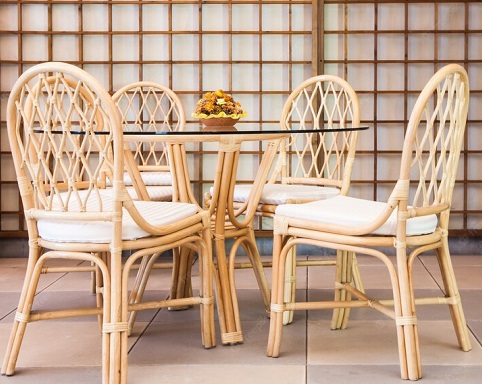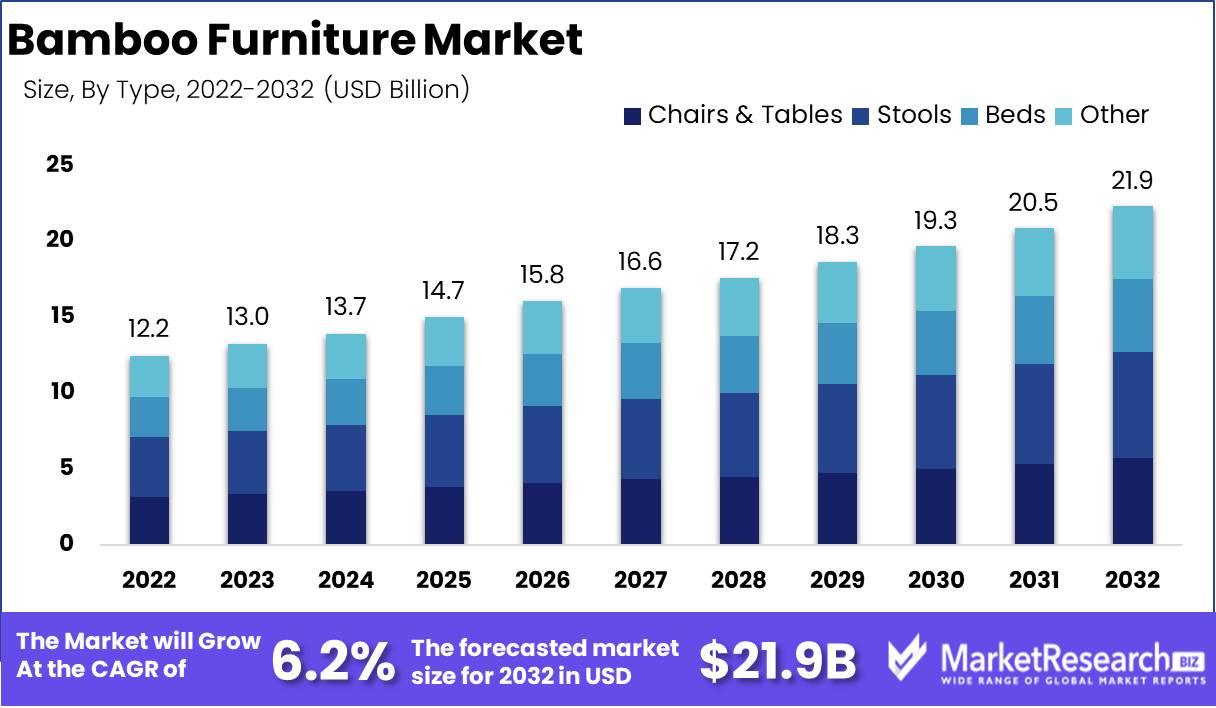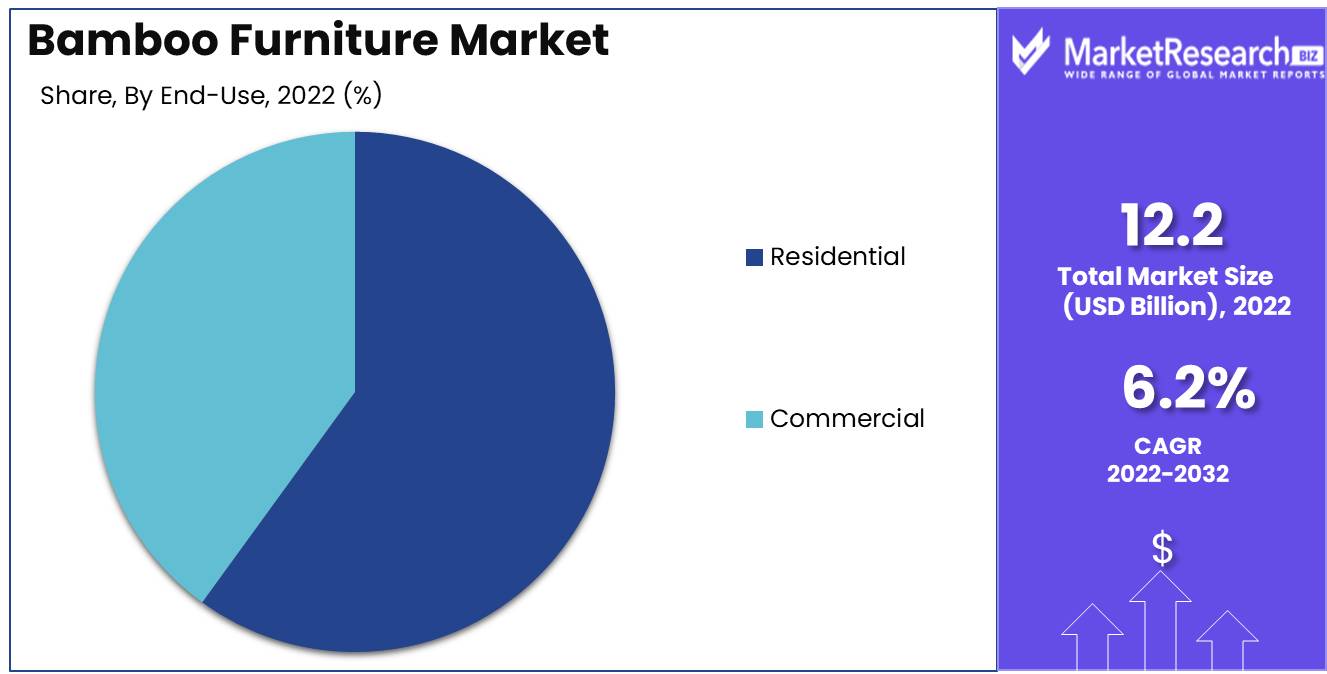
Global Bamboo Furniture Market By Type (Chairs & Tables, Stools, Beds, Other), By Distribution Channel (Online, Offline), By End-User (Residential, Commercial), By Region And Companies - Industry Segment Outlook, Market Assessment, Competition Scenario, Trends, And Forecast 2023-2032
-
38038
-
June 2023
-
175
-
-
This report was compiled by Research Team Research team of over 50 passionate professionals leverages advanced research methodologies and analytical expertise to deliver insightful, data-driven market intelligence that empowers businesses across diverse industries to make strategic, well-informed Correspondence Research Team Linkedin | Detailed Market research Methodology Our methodology involves a mix of primary research, including interviews with leading mental health experts, and secondary research from reputable medical journals and databases. View Detailed Methodology Page
-
Quick Navigation
Report Overview
The Global Bamboo Furniture Market size is expected to be worth around USD 21.9 Bn by 2032 from USD 12.2 Bn in 2022, growing at a CAGR of 6.2% during the forecast period from 2023 to 2032.
The global market for bamboo furniture is growing rapidly. Bamboo is a great alternative for eco-friendly furniture production due to its durability and growth. This comprehensive market study will examine this industry's goals, pioneering technologies, important investments, and growing applications for growth. We'll also discuss bamboo furniture's investing industries and the market's main drivers.

Due to its durability, eco-friendliness, and beauty, bamboo furniture has grown in popularity. Leading industry players are making significant investments in the production and distribution of bamboo-based furniture products as the global market for bamboo furniture manufacturing grows rapidly.
Recent innovations in bamboo furniture have boosted the global market. The utilization of bamboo composite materials, which combine bamboo with resin or plastic to create stronger, longer-lasting furniture, is one of these groundbreaking developments. The integration of bamboo into modular furniture systems offers users flexible and adaptable furniture.
The global bamboo furniture market includes investments in flooring, hospitality, and furniture design and manufacturing. Bamboo furniture integration is becoming more popular among interior designers and architects, resulting in the creation of unique, eco-friendly spaces.
The production of bamboo furniture is fraught with ethical dilemmas, as with any industry. Responsible bamboo furniture production must include environmental effects, fair labor policies, and sustainable manufacturing methods. During bamboo furniture production, certain companies have been accused of using cheap labor and environmentally harmful methods.
Transparency, explainability, and accountability underpin responsible bamboo furniture production. Companies must be transparent about their bamboo's origins, its growth and harvest, and their product manufacturing processes. Companies must also account for any environmental or labor impacts of their production methods.
Bamboo furniture is used in offices, retail stores, and hotels. Bamboo furniture can be customized to match design needs. Bamboo furniture aligns with the beliefs of many modern consumers, so businesses that prioritize sustainability and eco-friendliness can gain greatly.
Driving factors
Sustainable Bamboo Furniture Demand Rising
The growing demand for sustainable furniture is fueling the global bamboo furniture market's rapid expansion. Consumers, especially millennials, are becoming more eco-conscious and want eco-friendly furnishings. Bamboo is robust, fast-growing, and multifunctional. Bamboo looks good and fits modern house decor trends.
Market Regulations and Bamboo Furniture
As with any industry, there are potential regulatory changes that might have a big impact on bamboo furniture. Environmental concerns are causing governments worldwide to regulate hardwood use. Bamboo furniture makers may benefit from rising consumer demand for sustainable furniture.
New Technologies and Bamboo Furniture
3D printing and AI are expected to significantly impact the bamboo furniture sector. These technologies will be utilized to make complicated bamboo designs more efficiently and cheaply.
Bamboo Furniture Market Competitive Landscape Changing
In the coming years, potential disruptors are expected to transform the competitive landscape for the bamboo furniture market drastically. New market entries, raw material availability changes, and customer preferences change.
Bamboo Furniture and Consumer Trends
Finally, there are emerging trends and changes in consumer behavior that could impact the bamboo furniture industry. Remote working during the pandemic has raised the demand for ergonomic, flexible home furnishings. A growing proportion of consumers want furniture that fits smart home devices.
Restraining Factors
Challenges in the Bamboo Furniture Market
Due to its eco-friendliness, durability, and fashionable appearance, bamboo furniture has become extremely popular in recent years. However, the development of the global bamboo furniture market is hampered by a number of factors, such as the limited availability of high-quality bamboo and higher production costs.
Insufficient Bamboo Restrains Market
The scarcity of high-quality bamboo presents the greatest challenge for the global bamboo furniture market. Although bamboo is a fast-growing plant, it takes a number of years for it to attain the requisite thickness and strength for quality furniture. Moreover, the highest quality bamboo is primarily found in China and Southeast Asia, leaving only a few regions in the world dependent on low-quality bamboo.
Costs are Higher, and Bamboo is Scarce
Transporting bamboo over great distances increases its price, making it costly for manufacturers to acquire. The majority of bamboo importers choose to purchase in bulk to reduce shipping costs, necessitating manufacturers to store substantial quantities of bamboo prior to use. This can sometimes result in excess stock and excessive inventory levels, which ultimately leads to higher costs.
Seeking Sustainable Solutions
In addition to limited availability, higher production costs are another factor restraining the global bamboo furniture market. Bamboo furniture is made from bamboo poles using specialized machinery and expert labor. Before finishing bamboo poles, the procedure involves drying, cutting, treating, and shaping them.
Conquering Bamboo Restraints
As bamboo is a hard and durable timber, it requires more time and effort than softer woods to create furniture. Skilled labor is a necessary requirement, making it difficult for small manufacturers who cannot afford such costs. The manufacturing process also generates a substantial quantity of waste and scraps, which must be managed and disposed of properly.
Optimizing the Production of Bamboo Furniture
The global bamboo furniture market requires sustainable solutions in order to surmount the challenges posed by the limited availability of high-quality bamboo and the higher manufacturing costs. Bamboo must be harvested at specific times, allowing for the complete regeneration of new bamboo stalks and an increase in overall yield.
Type Analysis
Due to its sustainable nature and the wide range of advantages it offers, bamboo furniture has gained popularity in recent years. Among the various segments of bamboo furniture on the global market, the Stools Segment has been dominating. This segment has experienced a surge in demand due to its adaptability and other enticing characteristics that make it an ideal piece of contemporary furniture.
The segment of the global bamboo furniture market that consists of stools has been driven by economic growth in emerging economies. As a growing number of emerging nations achieve financial stability, their citizens are looking to invest in eco-friendly and sustainable furniture options, such as bamboo furniture. Not only is the Stools Segment highly sustainable, but it is also incredibly durable and aesthetically attractive.
Positive consumer trends and behavior have also been observed in the segment of stools. With characteristics such as portability, compactness, and lightweightness, bamboo stools have found a place in the modern world. Whether for compact apartments or as a solution for party seating, bamboo stools have become an essential piece of furniture.
Over the future years, it is anticipated that the stool segment of the global bamboo furniture market will register the fastest growth rate. This growth may be attributed to the segment's adaptability, which has made it a popular choice for both indoor and outdoor settings. Bamboo stools are destined to become a standard in homes around the globe due to their durable construction and minimalistic design.
Distribution Channel Analysis
Global furniture segments have been dominating the offline market segments when it comes to the distribution channel of bamboo furniture. Consumers continue to favor traditional brick-and-mortar furniture stores. For companies looking to break into the global bamboo furniture market, a strong offline presence is essential.
Significantly contributing to the adoption of the offline segment has been economic development in emerging economies. Consumers are looking to invest in durable and sustainable furniture options as the middle-class population in these nations grows. With a strong offline presence, companies selling bamboo furniture can market and sell their products by capitalizing on consumers' trust in physical locations.
Consumer trends and offline segment behavior have been relatively stable. Consumers still prefer to see and touch the furniture prior to making a purchase, making traditional stores the preferred venue for purchasing bamboo furniture. Nonetheless, as the number of e-commerce platforms has increased, so has the demand for online stores.
Over the future years, it is anticipated that the offline segment of the global bamboo furniture market will register the fastest growth rate. This growth may be attributed to the opening of tangible stores in emerging economies. To make an impact in these markets, businesses must establish a robust offline presence that appeals to consumers looking for eco-friendly furniture options.
End-User Analysis
With good cause, the residential segment dominates the global bamboo furniture market. Residential spaces have been quick to adapt sustainable furniture options, and bamboo furniture has followed suit. As people become more environmentally conscious, bamboo furniture has found a home in every room of the house, from the living room to the bedroom.
Economic growth in emerging nations has been the driving force behind the Residential Segment's adoption. People are looking for furniture options that are affordable, sustainable, and long-lasting as more and more people are able to purchase a home. Bamboo furniture meets all of these requirements, which has made it a popular option in emerging markets.
Sustainability and aesthetics have driven the Residential Segment consumer trend and behavior. People desire furniture that is both aesthetically pleasing and environmentally friendly. Because it offers both aesthetic appeal and environmental preservation, bamboo furniture has become the preferred option for consumers.
Over the future years, it is anticipated that the residential Segment of the global bamboo furniture market will register the fastest growth rate. This growth can be attributed to rising disposable incomes in emerging economies as well as a heightened awareness of sustainable living.

Key Market Segments
By Type
- Chairs & Tables
- Stools
- Beds
- Other Types
By Distribution Channel
- Online
- Offline
By End-User
- Residential
- Commercial
Growth Opportunity
Versatile and Durable
For its adaptability and durability, bamboo furniture is well-known in the market. Innovative designs are a significant factor in bamboo furniture's growing popularity. The furniture can be created in a variety of designs and styles to accommodate customers' requirements and preferences.
Innovative Designs with Bamboo
Due to its unique properties, bamboo can be fashioned into a variety of patterns, shapes, and configurations. The furniture can be created to be functional, contemporary, and artistic. The adaptability of bamboo furniture enables manufacturers to create breathtaking, multipurpose custom pieces. These unique designs increase the value and desirability of the furniture, making it more appealing to customers.
Customizable Appeal
The market for bamboo furniture is ripe for expansion. Due to the growing demand for eco-friendly products, the global market has been expanding. The demand for bamboo furniture in the Asia-Pacific region, particularly in India, China, and Japan, has increased substantially.
Expanding Global Demand
Particularly in Germany, France, and Italy, bamboo furniture has become a significant draw in the European market. The expansion of the global market for bamboo furniture is due to its quality, affordability, and eco-friendliness. The availability of bamboo furniture has increased significantly, making it readily available to customers around the globe.
Eco-friendly Market Expansion
Bamboo is a renewable and sustainable resource, making it an environmentally favorable option for furniture construction. Bamboo develops rapidly and can be harvested in one-third of the time required to harvest trees. Due to the wood's resistance to insects and maladies, the production of bamboo furniture uses fewer chemicals.
Sustainable Furniture Choice
The production of bamboo furniture also has a smaller environmental impact. The need for irrigation is reduced because bamboo thrives in regions with abundant precipitation. The bamboo root system preserves the soil, preventing soil erosion. Therefore, the production of bamboo furniture has a positive impact on the environment.
Positive Environmental Impact
Collaboration with designers contributes to the expansion potential of the bamboo furniture market. The collaboration between bamboo furniture manufacturers and designers has produced unique and functional furniture designs. Collaboration promotes innovation in the furniture sector.
Latest Trends
Changes in Preferences the Latest Trends in Bamboo Furniture
Due to the dominant market trends that are reshaping the industry, the global bamboo furniture market is experiencing a significant shift in consumer preferences. In this article, we will examine the most recent trends in the bamboo furniture industry that are swiftly transforming commercial sector adoption, hybrid designs, craftsmanship, and market expansion.
The Rise of Hybrid Bamboo Furniture Designs
The hybrid design trend has emerged in the bamboo furniture market. This new trend involves combining bamboo with materials like metal, glass, and fabrics. This innovative approach enhances the texture and overall aesthetics of the furniture, thereby increasing its appeal to consumers.
Craftsmanship Drives Demand for Bamboo Furniture
In addition to enhancing the aesthetic allure of bamboo furniture, hybrid designs have been found to enhance its durability and sustainability. Combinations of bamboo and metal, for instance, have been found to produce furniture that is more durable and resistant to extreme weather conditions. More bamboo furniture manufacturers are implementing this approach as hybrid designs become more and more popular with consumers.
Sustainable Partnerships Drive the Development of Bamboo Furniture
Another significant trend shaping the bamboo furniture market is craftsmanship. Consumers are seeking increasingly distinct, intricately designed, high-quality, and personalized furniture pieces. This trend has led to a rise in demand for handcrafted furniture pieces by expert artisans.
Commercial Achievement for Bamboo Furniture
More bamboo furniture manufacturers are embracing this trend by forming partnerships with artisans who specialize in handcrafted furniture pieces. This approach has helped to expedite the production process, reduce the carbon footprint, and meet the demand for unique and customized furniture pieces from consumers.
Increasing Demand for Bamboo Office Furniture
The commercial sector has also played a significant role in shaping the market for bamboo furniture. Globally, organizations and institutions are increasingly adopting eco-friendly and sustainable practices, and bamboo furniture ties in well with this ethos. Therefore, the commercial sector has become an important market for bamboo furniture.
Expanding Market Share of Versatile Bamboo in the Furniture Industry
Due to a number of factors, the demand for bamboo furniture in the commercial sector has increased substantially in recent years. For example, the durability and low cost of maintenance make bamboo furniture ideal for heavily utilized office spaces. In addition, bamboo furniture is environmentally sustainable and contributes to the CSR objectives of a company
Regional Analysis
Asia Pacific Bamboo Furniture Market with Largest Market Share (61.5%)
The Asia Pacific region dominates the global bamboo furniture market, accounting for a significant share of 61.5% in 2023, valued at approximately USD 7.5 billion. This dominance is driven by the region’s vast bamboo production, which supports a well-established bamboo furniture manufacturing base, particularly in countries like China, India, and Vietnam. The increasing demand for sustainable and eco-friendly furniture in residential and commercial spaces has further fueled growth.
The region’s preference for natural materials, coupled with bamboo's fast growth rate and renewability, positions it as a key driver of market trends. Additionally, the growing trend of minimalistic and sustainable living is enhancing the demand for bamboo furniture in Asia Pacific. The market is expected to continue its robust growth trajectory as local players capitalize on the growing eco-conscious consumer base and the expansion of retail distribution channels.
The North America bamboo furniture market has witnessed steady growth, driven by the increasing consumer shift towards sustainable and eco-friendly products. As environmental awareness grows, the demand for bamboo furniture, particularly in the United States and Canada, is gaining momentum. The region’s market is expected to grow due to rising consumer preference for renewable materials, with the eco-friendly appeal of bamboo being a key factor.
Europe holds a moderate share of the global bamboo furniture market. The market growth is largely driven by the increasing adoption of sustainable and eco-friendly furniture, particularly in countries like Germany, the UK, and France. The growing trend of sustainable living, along with the rising awareness of bamboo’s environmental benefits, is fostering demand for bamboo furniture.
The Middle East and Africa bamboo furniture market is emerging, with relatively low market penetration compared to other regions. However, there is an increasing interest in sustainable and natural materials, especially among eco-conscious consumers in countries like the UAE, Saudi Arabia, and South Africa. Growing construction activities and a shift towards more sustainable housing and interior decor options are factors driving the market. As urbanization and wealth increase in the Middle East, there is a rising demand for luxury bamboo furniture, especially among the high-income demographic.
In Latin America, the bamboo furniture market remains relatively small but is showing signs of growth. The rising awareness of sustainability and environmental issues is gradually driving demand in countries like Brazil, Argentina, and Mexico.

Key Regions and Countries
North America
- US
- Canada
- Mexico
Western Europe
- Germany
- France
- The UK
- Spain
- Italy
- Portugal
- Ireland
- Austria
- Switzerland
- Benelux
- Nordic
- Rest of Western Europe
Eastern Europe
- Russia
- Poland
- The Czech Republic
- Greece
- Rest of Eastern Europe
APAC
- China
- Japan
- South Korea
- India
- Australia & New Zealand
- Indonesia
- Malaysia
- Philippines
- Singapore
- Thailand
- Vietnam
- Rest of APAC
Latin America
- Brazil
- Colombia
- Chile
- Argentina
- Costa Rica
- Rest of Latin America
Middle East & Africa
- Algeria
- Egypt
- Israel
- Kuwait
- Nigeria
- Saudi Arabia
- South Africa
- Turkey
- United Arab Emirates
- Rest of MEA
Key Players Analysis
Due to the rising demand for environmentally sustainable furniture products, the global bamboo furniture market is experiencing significant expansion. This market is dominated by Bambeco Inc., Moso, Greenington LLC, VivaTerra, and Pole To Pole.
Bambeco Inc. is an American company that specializes in eco-friendly home decor. Its range of bamboo furniture includes chairs, tables, and shelving. Bambeco utilizes eco-friendly packaging materials and a sustainable method for procuring raw materials.
Moso is a company situated in the Netherlands that offers a comprehensive range of bamboo products, including furniture. For both indoor and outdoor use, it has a wide range of bamboo furniture, including chairs, tables, and stools.
Greenington LLC is a U.S.-based company that offers bamboo furniture that is eco-friendly. Its range of products includes mattresses, chairs, tables, and living room furniture. The company's commitment to sustainable practices has earned it several distinctions, including the 2020 Excellence Award from the Sustainable Furnishings Council.
VivaTerra is a U.S.-based company that offers sustainable collections of bamboo and wood furniture. Its range includes outdoor furniture, seating, dining tables, and home accessories.
Pole To Pole is a Singaporean company that specializes in bamboo and reclaimed teak eco-friendly furniture. The company's product range includes a broad range of indoor and outdoor furniture, including beds, chairs, tables, and accessories.
Top Key Players in the Bamboo Furniture Market
- Greenington LLC
- VivaTerra
- Pole To Pole
- CBG Bamboo Garden Products Co., Ltd.
- Moso International
- Tanyee Company Ltd.
- Jiangxi Feiyu Bamboo Industry Group Co. Ltd
- Shenzhen Vincent Handicraft Co., Limited
- Interwood
- Hanssem Co. Ltd.
- IKEA
- Utsav Handicraft
- Other Key Players
Recent Development
- In 2023, IKEA announced that it would start selling bamboo furniture in its stores. The move is part of the company's endeavors to provide customers with sustainable and renewable products.
- In 2022, Ashley Furniture announced that it would expand its bamboo furniture line. This decision was made in response to the growing demand for sustainable furniture alternatives. T
- In 2021, Restoration Hardware announced the introduction of a new bamboo furniture line. The company is well-known for its luxury household goods and furniture, which makes this announcement a significant market move.
- In 2020, West Elm announced that it would expand its selection of bamboo furniture. This announcement was made in response to the growing demand for sustainable furniture options.
Report Scope:
Report Features Description Market Value (2022) USD 12.2 Bn Forecast Revenue (2032) USD 21.9 Bn CAGR (2023-2032) 6.2% Base Year for Estimation 2022 Historic Period 2016-2022 Forecast Period 2023-2032 Report Coverage Revenue Forecast, Market Dynamics, COVID-19 Impact, Competitive Landscape, Recent Developments Segments Covered By Type (Chairs & Tables, Stools, Beds, Other Types), By Distribution Channel (Online, Offline), By End-User (Residential, Commercial) Regional Analysis North America – The US, Canada, & Mexico; Western Europe – Germany, France, The UK, Spain, Italy, Portugal, Ireland, Austria, Switzerland, Benelux, Nordic, & Rest of Western Europe; Eastern Europe – Russia, Poland, The Czech Republic, Greece, & Rest of Eastern Europe; APAC – China, Japan, South Korea, India, Australia & New Zealand, Indonesia, Malaysia, Philippines, Singapore, Thailand, Vietnam, & Rest of APAC; Latin America – Brazil, Colombia, Chile, Argentina, Costa Rica, & Rest of Latin America; Middle East & Africa – Algeria, Egypt, Israel, Kuwait, Nigeria, Saudi Arabia, South Africa, Turkey, United Arab Emirates, & Rest of MEA Competitive Landscape Greenington LLC, VivaTerra, Pole To Pole, CBG Bamboo Garden Products Co., Ltd., Moso International, Tanyee Company Ltd., Jiangxi Feiyu Bamboo Industry Group Co. Ltd, Shenzhen Vincent Handicraft Co., Limited, Interwood, Hanssem Co. Ltd., IKEA, Utsav Handicraft, Other Key Players Customization Scope Customization for segments, region/country-level will be provided. Moreover, additional customization can be done based on the requirements. Purchase Options We have three licenses to opt for: Single User License, Multi-User License (Up to 5 Users), Corporate Use License (Unlimited User and Printable PDF) -
-
- Greenington LLC
- VivaTerra
- Pole To Pole
- CBG Bamboo Garden Products Co., Ltd.
- Moso International
- Tanyee Company Ltd.
- Jiangxi Feiyu Bamboo Industry Group Co. Ltd
- Shenzhen Vincent Handicraft Co., Limited
- Interwood
- Hanssem Co. Ltd.
- IKEA
- Utsav Handicraft
- Other Key Players




